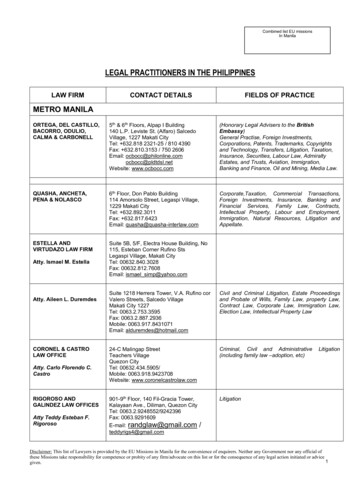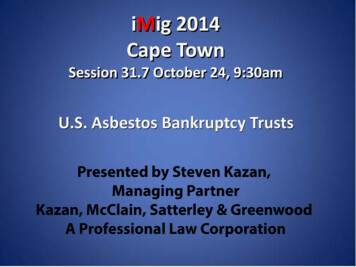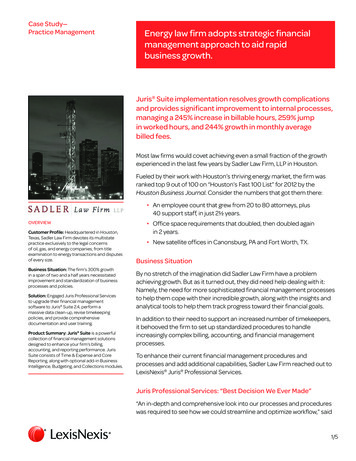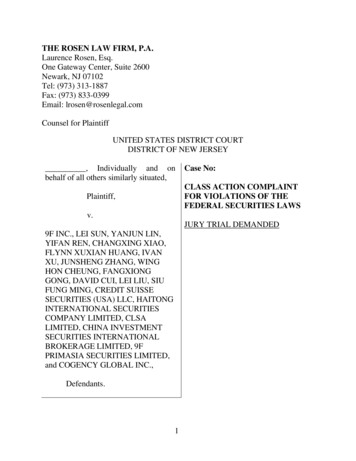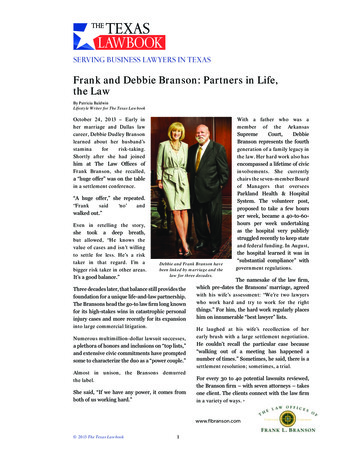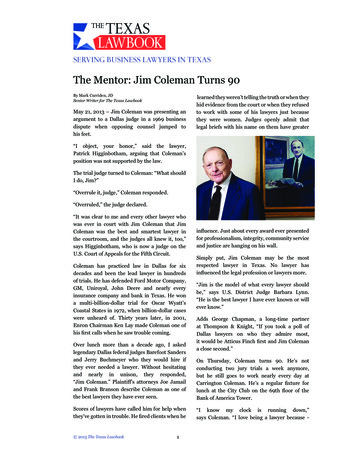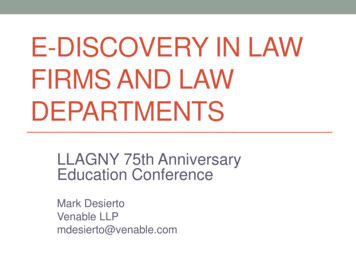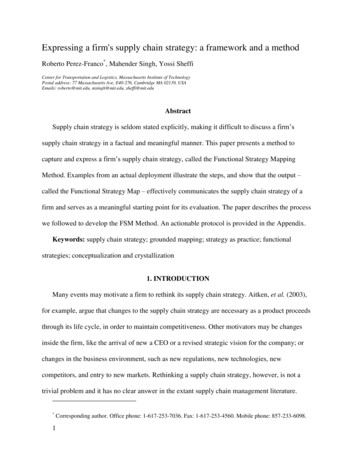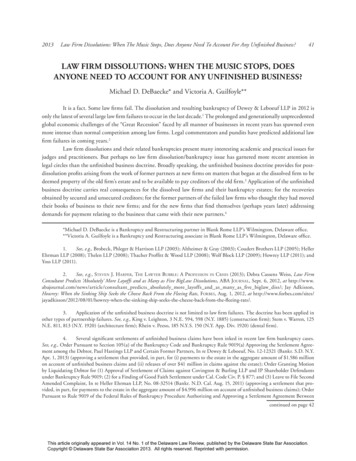
Transcription
2013Law Firm Dissolutions: When The Music Stops, Does Anyone Need To Account For Any Unfinished Business?41LAW FIRM DISSOLUTIONS: WHEN THE MUSIC STOPS, DOESANYONE NEED TO ACCOUNT FOR ANY UNFINISHED BUSINESS?Michael D. DeBaecke* and Victoria A. Guilfoyle**It is a fact. Some law firms fail. The dissolution and resulting bankruptcy of Dewey & Leboeuf LLP in 2012 isonly the latest of several large law firm failures to occur in the last decade.1 The prolonged and generationally unprecedentedglobal economic challenges of the “Great Recession” faced by all manner of businesses in recent years has spawned evenmore intense than normal competition among law firms. Legal commentators and pundits have predicted additional lawfirm failures in coming years.2Law firm dissolutions and their related bankruptcies present many interesting academic and practical issues forjudges and practitioners. But perhaps no law firm dissolution/bankruptcy issue has garnered more recent attention inlegal circles than the unfinished business doctrine. Broadly speaking, the unfinished business doctrine provides for postdissolution profits arising from the work of former partners at new firms on matters that began at the dissolved firm to bedeemed property of the old firm’s estate and to be available to pay creditors of the old firm.3 Application of the unfinishedbusiness doctrine carries real consequences for the dissolved law firms and their bankruptcy estates; for the recoveriesobtained by secured and unsecured creditors; for the former partners of the failed law firms who thought they had movedtheir books of business to their new firms; and for the new firms that find themselves (perhaps years later) addressingdemands for payment relating to the business that came with their new partners.4*Michael D. DeBaecke is a Bankruptcy and Restructuring partner in Blank Rome LLP’s Wilmington, Delaware office.**Victoria A. Guilfoyle is a Bankruptcy and Restructuring associate in Blank Rome LLP’s Wilmington, Delaware office.1.See, e.g., Brobeck, Phleger & Harrison LLP (2003); Altheimer & Gray (2003); Coudert Brothers LLP (2005); HellerEhrman LLP (2008); Thelen LLP (2008); Thacher Proffitt & Wood LLP (2008); Wolf Block LLP (2009); Howrey LLP (2011); andYoss LLP (2011).2.See, e.g., Steven J. H arper, The L awyer Bubble : A Profession in Crisis (2013); Debra Cassens Weiss, Law FirmConsultant Predicts ‘Absolutely’ More Layoffs and as Many as Five BigLaw Dissolutions, ABA Journal, Sept. 6, 2012, at http://www.abajournal.com/news/article/consultant predicts absolutely more layoffs and as many as five biglaw diss/; Jay Adkisson,Howrey: When the Sinking Ship Seeks the Cheese Back From the Fleeing Rats, Forbes, Aug. 1, 2012, at k-from-the-fleeing-rats/.3.Application of the unfinished business doctrine is not limited to law firm failures. The doctrine has been applied inother types of partnership failures. See, e.g., King v. Leighton, 3 N.E. 594, 598 (N.Y. 1885) (construction firm); Stem v. Warren, 125N.E. 811, 813 (N.Y. 1920) (architecture firm); Rhein v. Peeso, 185 N.Y.S. 150 (N.Y. App. Div. 1920) (dental firm).4.Several significant settlements of unfinished business claims have been inked in recent law firm bankruptcy cases.See, e.g., Order Pursuant to Section 105(a) of the Bankruptcy Code and Bankruptcy Rule 9019(a) Approving the Settlement Agreement among the Debtor, Paul Hastings LLP and Certain Former Partners, In re Dewey & Leboeuf, No. 12-12321 (Bankr. S.D. N.Y.Apr. 1, 2013) (approving a settlement that provided, in part, for (i) payments to the estate in the aggregate amount of 1.586 millionon account of unfinished business claims and (ii) releases of over 41 million in claims against the estate); Order Granting Motionby Liquidating Debtor for (1) Approval of Settlement of Claims against Covington & Burling LLP and IP Shareholder Defendantsunder Bankruptcy Rule 9019; (2) for a Finding of Good Faith Settlement under Cal. Code Civ. P. § 877; and (3) Leave to File SecondAmended Complaint, In re Heller Ehrman LLP, No. 08-32514 (Bankr. N.D. Cal. Aug. 15, 2011) (approving a settlement that provided, in part, for payments to the estate in the aggregate amount of 4.996 million on account of unfinished business claims); OrderPursuant to Rule 9019 of the Federal Rules of Bankruptcy Procedure Authorizing and Approving a Settlement Agreement Betweencontinued on page 42This article originally appeared in Vol. 14 No. 1 of the Delaware Law Review, published by the Delaware State Bar Association.Copyright Delaware State Bar Association 2013. All rights reserved. Reprinted with permission.
42Delaware Law ReviewVolume 14:1This article delves into the unfinished business doctrine as applied in law firm dissolutions, including a detaileddiscussion of recent competing decisions issued in 2012 by two district court judges in the Southern District of New York.5Those courts reached opposite conclusions on whether the unfinished business doctrine applies under New York law tohourly fee matters pending upon the dissolution of a law firm.I. THE UNFINISHED BUSINESS DOCTRINEUNDER APPLICABLE STATE PARTNERSHIP LAWQuestions concerning application of the unfinished business doctrine in law firm dissolutions arise under afamiliar fact pattern. A departing partner of a dissolved law firm joins a new firm. The departing partner asks a client shehad been performing work for at the dissolved firm whether the client wishes to move its pending matter to the partner’snew firm. The client agrees and the new firm then enters into an agreement with the client to handle the pending matter(i.e. the unfinished business). The new firm and its new partner provide services to complete the pending matter andreceive payment for those services from the client. Thereafter, the dissolved former firm (or its bankruptcy estate) and/or former partners at the dissolved firm demand that the new firm and the departed partner turnover at least the profitsreceived from the completion of the unfinished business.“Unfinished business” has been defined as “executory contracts to perform services, begun but not fully performedby the partnership on the date of its dissolution.”6 Unfinished business is not to be confused with “finished business” or“new business”, neither of which falls under application of the unfinished business doctrine.7 According to at least onecourt, “[u]nfinished business exists until it is finished, and therefore the [t]rustee, if entitled, can recover any realized[u] nfinished [b]usiness profits no matter when such business was or is concluded.”8 The unfinished business doctrinecontinued from page 41the Plan Administrator and Baker & McKenzie LLP, Dev. Specialists, Inc., in its capacity as Plan Administrator for Coudert BrothersLLP v. Baker & McKenzie LLP, No. 09-1150 (Bankr. S.D. N.Y. Aug. 20, 2010) (approving a settlement that provided, in part, for (i)payments to the estate in the aggregate amount of 6.65 million on account of unfinished business claims and (ii) an agreement toshare approximately 17 million in contingent fees).5.Dev. Specialists, Inc. v. Akin Gump Strauss Hauer & Feld LLP (In re Coudert Bros. LLP), 480 B.R. 145 (S.D. N.Y.2012) (hereafter, “Coudert Bros.”); Geron v. Robinson & Cole LLP (In re Thelen LLP), 476 B.R. 732 (S.D. N.Y. 2012) (hereafter,“Thelen”).6.Coudert Bros., 480 B.R. at 161. See Greenspan v. Orrick, Herrington & Sutcliffe LLP (In re Brobeck, Phleger &Harrison LLP), 408 B.R. 318, 333 (Bankr. N.D. Cal. 2009) (hereafter, “Brobeck”) (“Under California law, the unfinished business ofa law partnership is any business covered by retainer agreements between the firm and its clients for the performance of partnershipservices that existed at the time of dissolution.”)7.“Finished business” is “business that has been completed prior to dissolution (the merger done and documented; thelawsuit tried to verdict or settled).” Coudert Bros., 480 B.R. at 160. “New business” is an entirely new engagement entered into with adissolved firm’s former client that followed a former partner to the new firm. Id. at 160-61; see also Brobeck, 408 B.R. at 333 (“However,a critical distinction exists between ‘unfinished business,’ which remains a partnership asset and for which each partner has a fiduciaryduty to complete, and ‘new’ business which is not a partnership asset and may follow the individual partner.”)8.Brobeck, 408 B.R. at 332 n.15 (rejecting time period limit on recovery as argued by the defendant firms and attorneys);compare Official Comm. of Unsecured Creditors v. Ashdale (In re Labrum & Doak, LLP), 227 B.R. 391, 396 (Bankr. E.D. Pa. 1998)(hereafter, “Labrum & Doak”) (creditors’ committee voluntarily limited unfinished business claims to fees collected by former partnersand their new firms on unfinished business in the one year period following dissolution of debtor law firm).This article originally appeared in Vol. 14 No. 1 of the Delaware Law Review, published by the Delaware State Bar Association.Copyright Delaware State Bar Association 2013. All rights reserved. Reprinted with permission.
2013Law Firm Dissolutions: When The Music Stops, Does Anyone Need To Account For Any Unfinished Business?43rests on the legal principle that, absent an enforceable agreement stating otherwise, a departing partner owes a fiduciaryduty to the dissolved firm and her former partners to account for benefits obtained from use of partnership property inwinding up the business of the partnership.9Well-drafted partnership agreements generally address (i) whether unfinished business constitutes a partnershipasset and (ii) whether, upon dissolution, partners owe a duty to account for unfinished business. The partnership agreement should govern resolution of the issues, provided the provisions themselves are not subject to attack under laws suchas applicable state or federal fraudulent transfer statutes. But, in the absence of controlling partnership agreement provisions, the questions of whether (i) unfinished business constitutes property of the partnership’s bankruptcy estate and, ifso, (ii) former partners owe a fiduciary duty to account to their dissolved firm and former partners for profits relating tounfinished business, are largely controlled by applicable state law, particularly applicable state partnership statutes.A discussion of applicable state law begins with the Uniform Partnership Act of 1914 (“UPA”). The UPA hasbeen adopted by every state, except Louisiana.10 Subsequent revisions to the UPA, commonly referred to as “RUPA” orthe Revised Uniform Partnership Act, have been adopted by thirty-seven states, including Delaware and California, butexcluding New York and Pennsylvania.11According to the states’ codifications of UPA or RUPA, partnership property refers to all property, whether real,personal or mixed, tangible or intangible, or any interest held therein, that is owned by the partnership.12 Under the lawsof most states, in the absence of an express provision to the contrary in the applicable partnership agreement, a partner owesa fiduciary duty of loyalty to account to the partnership and her former partners with respect to any property, profit orbenefit obtained in the conduct or winding up of partnership business.13Importantly, application of the unfinished business doctrine to law firms has not been limited to firms formedunder state partnership laws. The doctrine has been applied in dissolutions of law firms formed as professional corporations,9.The unfinished business doctrine has been applied in the context of law firm dissolutions. It does not appear to havebeen applied in a situation where a partner simply leaves her solvent operating law firm, joins a new firm while her old firm continuesoperating, and then clients of the old firm engage her at the new firm to continue working on the client’s pending matters. See, e.g.,Coudert Bros., 480 B.R. at 151, n.1; Heller Ehrman LLP v. Jones Day (In re Heller Ehrman LLP), No. 10-3221, 2013 Bankr. LEXIS889, at *12-15 (Bankr. N.D. Cal. Mar. 11, 2013) (hereafter, “Heller 2013”).Unfinished business claims in the context of a law firm’s dissolution are not the only possible claims against departing partners. See, e.g., Trustee’s Motion, Pursuant to Bankruptcy Rule 9019, for an Order (A) Approving Settlement Agreements withCertain Former Partners of the Debtor; (B) Finding that Such Settlements are in Good Faith; and (C) Barring Certain Claims againstSettling Partners, In re Thelen, LLP, No. 09-15631 (Bankr. S.D. N.Y. Sept. 28, 2011) (describing claims against former partners,including claims related to alleged overcompensation received by the partners in violation of the relevant partnership agreements,unpaid capital contribution requirements, and unpaid loans or other advances made by the debtor law firm on behalf of the partnersfor a variety of reasons, including payment of health insurance and other personal expenses).10. See Uniformlaws.org, Legislative Fact Sheet – Partnership Act, at px?title Partnership Act (last visited Apr. 18, 2013).11. Id.; see also Delaware Revised Uniform Partnership Act, Del. Code A nn. tit. 6, ch. 15 (2005 and Supp. 2012) (“DRUPA”); California Revised Uniform Partnership Act of 1994, Cal. Corp. Code §§ 16100-16962 (2006 and Supp. 2013) (“CRUPA”).12.See, e.g., DRUPA § 15-101(17); CRUPA § 16101(15).13. See, e.g., DRUPA § 15-404(b)(1)(“A partner’s duty of loyalty to the partnership and the other partners is limited tothe following: (1) to account to the partnership and hold as trustee for it any property, profit or benefit derived by the partner in theconduct or winding up of the partnership business or affairs or derived from a use by the partner of partnership property, includingthe appropriation of a partnership opportunity; ”); CRUPA § 16404(b)(1) (substantially similar).This article originally appeared in Vol. 14 No. 1 of the Delaware Law Review, published by the Delaware State Bar Association.Copyright Delaware State Bar Association 2013. All rights reserved. Reprinted with permission.
44Delaware Law ReviewVolume 14:1limited liability companies, and even in a case involving a “hybrid” limited liability partnership.14 Moreover, “dissolution”does not equate to “termination”.15 A dissolved law firm continues in existence until its affairs are “wound up.”16II. CASE LAW DEVELOPMENT OF THE UNFINISHED BUSINESS DOCTRINEIt is well-settled in many states that, absent contrary provisions in a partnership agreement, the unfinishedbusiness doctrine applies to contingency fee matters pending upon dissolution of a law firm.17 Absent an agreement to thecontrary, partners who take with them to their new places of employment contingency fee cases they were handling atthe time of their old firm’s dissolution likely will have a duty to account to the old firm for at least a portion of the feesreceived from those contingency cases.18Several courts recently have wrestled with the question of whether, in the absence of an enforceable agreementamong the former partners, the unfinished business doctrine applies to hourly fee matters pending with the dissolved firmat the time of its dissolution. These hourly fee matters typically get moved by the clients to a new firm in conjunction withthe new firm’s hiring of the responsible partner. The new firm receives fees as a result of work performed on the hourlyfee matters. Then the questions become whether the former partner or new firm must account for the fees received and ifso, whether reasonable compensation for the “efforts, skill and diligence” utilized to obtain such fees may be deducted toreduce the amount owed to the dissolved firm. State and federal courts across the country have been asked to decide thesequestions in the context of law firm dissolutions. They are not all reaching the same conclusions.14. See, e.g., Santalucia v. Sebright Transp., Inc., 232 F.3d 293, 299 (2d Cir. 2000) (hereafter, “Santalucia”) (applyingunfinished business doctrine to law firm practicing as professional corporation formed under New York law) (citations omitted); Sufrinv. Hosier, 896 F. Supp. 766 (N.D. Ill. 1995) (applying unfinished business doctrine to law firm practicing as professional corporationformed under Illinois law); Heller Ehrman LLP v. Arnold & Porter LLP (In re Heller Ehrman LLP), No. 10-3203, 2011 Bankr. LEXIS1497, at *6-12 (Bankr. N.D. Cal. Apr. 22, 2011) (hereafter, “Heller 2011”) (applying unfinished business doctrine where debtor lawfirm was a California limited liability partnership, managing general partner was a California professional corporation, remainingpartners consisted of several other professional corporations incorporated in California and other states, and the individual attorneypartners were members of the various professional corporations); id. at *7 (“Even though the court agrees that RUPA is inapplicable,it disagrees with Defendant’s contention that – absent the Jewel waiver – the Shareholders had no duty to account for profits fromunfinished business.”); Rothman v. Dolin, 24 Cal. Rptr. 2d 571, 572 n.3 (Cal. Ct. App. 1993) (unfinished business doctrine appliesto professional law corporations formed under California law); Fox v. Abrams, 210 Cal. Rptr. 260, 265 (Cal. Ct. App. 1985) (same).15. Coudert Bros., 480 B.R. at 155 (“Dissolution is not termination.”) (quoting Scholastic, Inc. v. Harris, 259 F.3d 73, 85(2d Cir. 2001) (citing New York Partnership Law §§ 60, 61)).16. Coudert Bros., 480 B.R. at 155-56 (“Instead, the partnership ‘continues’ in existence until the ‘winding up’ of its affairsis completed.”)17.Id. at 163-64 (collecting cases).18. See, e.g., Santalucia, 232 F.3d at 298 (applying New York law) (“Thus, in a case where a lawyer departs from a dissolvedpartnership and takes with him a contingent fee case which he then litigates to settlement, the dissolved firm is entitled only to thevalue of the case at the date of dissolution, with interest . Stated conversely, the lawyer must remit to his former firm the settlementvalue, less that amount attributable to the lawyer’s efforts after the firm’s dissolution.”) (citations omitted).This article originally appeared in Vol. 14 No. 1 of the Delaware Law Review, published by the Delaware State Bar Association.Copyright Delaware State Bar Association 2013. All rights reserved. Reprinted with permission.
2013Law Firm Dissolutions: When The Music Stops, Does Anyone Need To Account For Any Unfinished Business?45A. Jewel v. BoxerNow to the case law. Jewel v. Boxer19 is the seminal unfinished business doctrine case dealing with law firms. InJewel, a four-partner California law firm dissolved in 1977. Two of the partners (Messrs. Jewel and Leary) formed one newfirm, and the other two partners (Messrs. Boxer and Elkind) formed another new firm. At their dissolved firm, the formerpartners had no written partnership agreement and no agreement allocating fees from active cases upon dissolution.20 Atthe time of dissolution, the old firm was handling various types of cases, apparently with an emphasis on personal injuryand workers compensation cases.21 When the new firms were formed, the respective partners at the new firms were hiredby the clients whose cases were handled by such partners at the old firm.22Several years later, a dispute arose as to the proper allocation of attorneys’ fees received by the new firms fromcompletion of the old firm’s cases that remained open at the time of dissolution. Following a bench trial, the court allocated post-dissolution income to the old and new firms on a quantum meruit basis.23 In a somewhat Byzantine process,the court first determined the former partners’ respective partnership interests in income of the old firm: 30% for Jewel,27% for Boxer, 27% for Elkind, and 16% for Leary. The court then allocated t
services that existed at the time of dissolution.”) 7. “Finished business” is “business that has been completed prior to dissolution (the merger done and documented; the lawsuit tried to verdict or settled).” Coudert Bros., 480 B.R. at 160. “New bu
